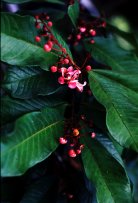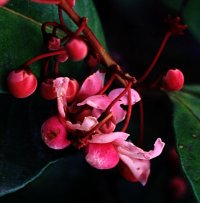 |
QUICK SEARCH
MO PROJECTS:
Africa
Asia/Pacific
Mesoamerica
North America
South America
General Taxonomy
Photo Essays
Training in Latin
America
MO RESEARCH:
Wm. L. Brown Center
Bryology
GIS
Graduate Studies
Research Experiences
for Undergraduates
Imaging Lab
Library
MBG Press
Publications
Climate Change
Catalog Fossil Plants
MO DATABASES:
W³MOST
Image Index
Rare Books
Angiosperm
Phylogeny
Res Botanica
All Databases
INFORMATION:
What's New?
People at MO
Visitor's Guide
Herbarium
Jobs & Fellowships
Symposium
Research Links
Site Map
Search
|
Draft Treatments | Guidelines | Checklist | Citing | Editors The Cutting EdgeVolume X, Number 4, October 2003News and Notes | Recent Treatments | Leaps and Bounds | Germane Literature | Season's Pick SEASON'S PICK: Couratari guianensis Aubl. -- LECYTHIDACEAE
As usual (!), nothing unusual, but a superb photo by INBio curator Francisco Morales, wins pick of the season for this issue. Although not uncommon in Costa Rica, this species is listed on the 2000 IUCN Red List of Threatened Species as "vulnerable...due to overexploitation and habitat loss." The species reaches no further up the Central American isthmus than Costa Rica, but otherwise has a solidly Amazonian distribution, occurring in all countries of the Amazon watershed. In Costa Rica it is known only from the Pacific lowlands (100-500 m), from south of San José to the Osa Península. This photo is vouchered by J. F. Morales 9879. In any case, the species is appropriate for this season since the peak flowing time appears to be September; all of the flowering specimens from Costa Rica, on TROPICOS and ATTA, were collected during that month. At this time of year, in certain areas of the Osa Península (eg., the forested hills at the end of the abandoned air strip near Rincón de Osa), the flowering canopy of this large tree colors the hillsides with spectacular dollops of pink. Side note: please ignore the "Limón" locality for Hammel 21066 on the INBio website for this species; the correct coordinates for that and hundreds of other collections of Hammelís (in the range of #ís 21000--22710, now incorrectly as "Limón" province) have not yet been entered into the INBio database. |
© 1995-2025 Missouri Botanical Garden, All Rights Reserved
4344 Shaw Blvd.
St. Louis, MO 63110
(314) 577-5100
Technical Support

